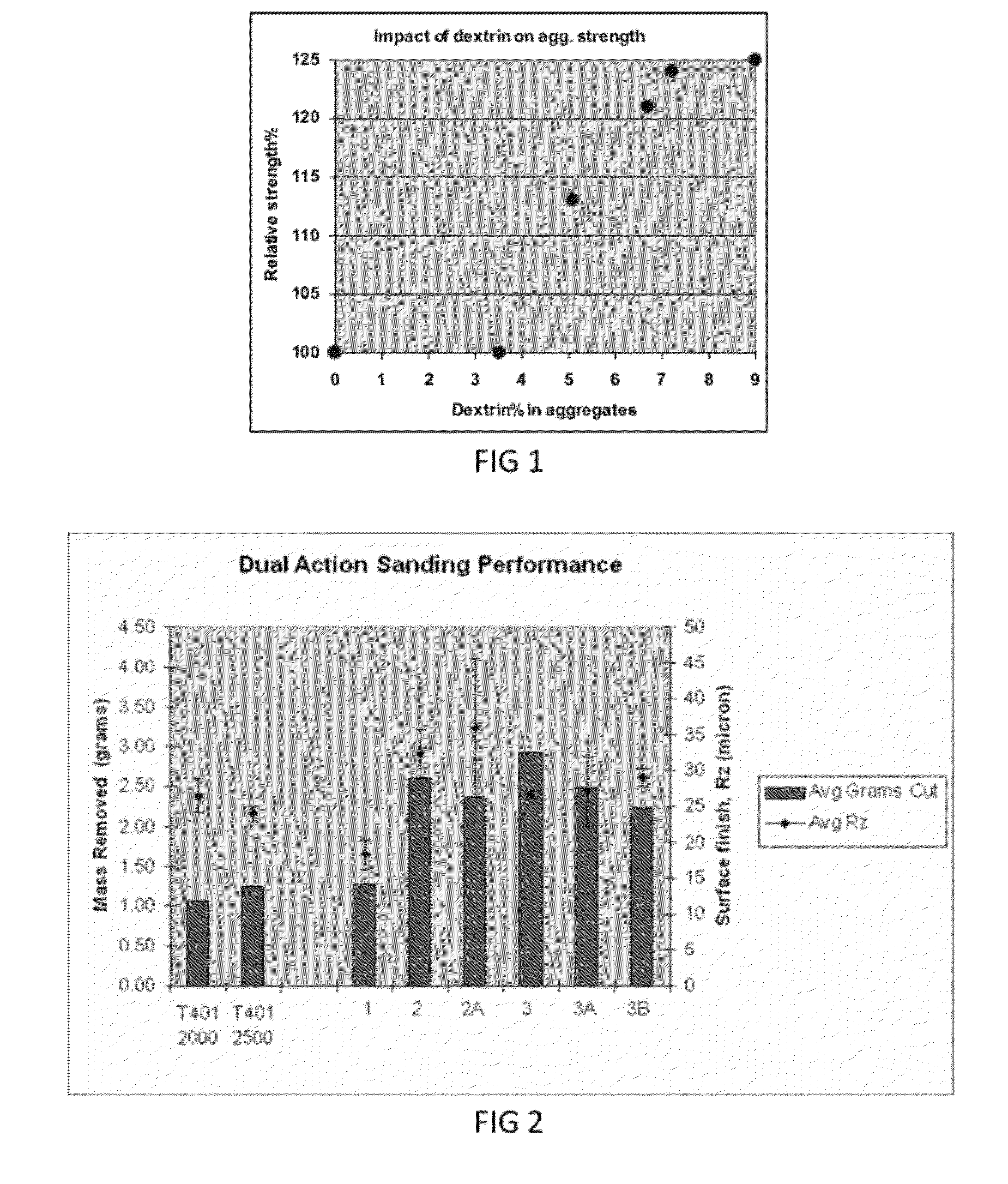Coated abrasive aggregates and products containg same
a technology of abrasive aggregates and products, applied in the field of abrasive particulate materials, can solve the problems of low material removal rate, increased cost, and slow production
- Summary
- Abstract
- Description
- Claims
- Application Information
AI Technical Summary
Problems solved by technology
Method used
Image
Examples
example 1
Impact of Cross-Linking Agent on Aggregate Strength
[0092]Applicants prepared spray dried aggregates containing SiC abrasive grains according to U.S. Patent Application Publication US 2008 / 0172951 to Starling. The original plasticizer of Starling was used, not the dual function material of the embodiments of the present disclosure. A cross-linking agent, dextrin, was added in various amounts to five samples. A control sample without the cross-linking agent was also produced. The only difference between the aggregates produced was the amount of cross-linking agent incorporated.
[0093]The aggregate samples subjected to a crush test as follows: the aggregates were screened at a mesh size of 200 and 5 grams of each sample were placed in a one inch die. The die was then subjected to a pressure of 5 MPa. The collected aggregate was again screened and the amount that passed through to be collected on a 270 mesh was recorded. The higher the % of material that passed through (−200 / +270), t...
example 2
Impact of Dual Function Material on Aggregate Strength
[0094]Aggregates containing dextrin and zinc stearate were prepared according to the present disclosure, and subjected to a crush test as described in Example 1. The results are shown as follows.
BondCrush %Aggregate Composition (dry wt %)Wt %(−200 / +270)Bindzil2040 + 5.7% dextrin50.346Bindzil2040 + 5.7% dextrin + 3.5% Zn stearate53.934Bindzil2040 + 5.7% dextrin + 6.7% Zn stearate55.833
[0095]The bond wt % is equal to the sum of the dry weight percents of the components of the spray dried aggregate excluding the weight of the abrasive grains. The results show that the initial addition of zinc stearate does contribute an improvement to the strength of the aggregate, but that increasing the amount of the zinc stearate does not improve the strength by an appreciable amount. Thus, primary contributor to aggregate strength is the dextrin.
example 3
Production of Aggregate 1-Starling
[0096]A slurry mixture for forming fine abrasive aggregates including silicon carbide grit combined with silica nanoparticles was produced by the following method, according to U.S. Patent Application Publication US 2008 / 0172951 to Starling. Aqueous colloidal silica was mixed with green silicon carbide grit (NGC 2500, available from Nanko Abrasives, Inc. of Tokyo, Japan), JIS graded (JIS2500), having an average particle size of 5.5 microns, along with a polyethylene glycol (PEG) 200 plasticizer and deionized water. The silica sol used was BINDZIL 2040, available from Eka Chemicals Inc. of Marietta, Ga., which is believed to be aqueous colloidal silica solution having about 40% silica (SiO2) by weight, a silica particle size of about 20 nm, and a base-stabilized pH of about 10.
[0097]The components were mixed in the following amounts:
ComponentGrams in mixtureWt. % in mixtureBINDZIL 2040 silica sol360062.9PEG 2002203.8Deionized water3005.2NGC 2500 gr...
PUM
 Login to View More
Login to View More Abstract
Description
Claims
Application Information
 Login to View More
Login to View More - R&D
- Intellectual Property
- Life Sciences
- Materials
- Tech Scout
- Unparalleled Data Quality
- Higher Quality Content
- 60% Fewer Hallucinations
Browse by: Latest US Patents, China's latest patents, Technical Efficacy Thesaurus, Application Domain, Technology Topic, Popular Technical Reports.
© 2025 PatSnap. All rights reserved.Legal|Privacy policy|Modern Slavery Act Transparency Statement|Sitemap|About US| Contact US: help@patsnap.com



